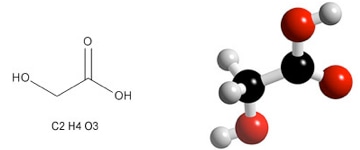Glycolic acid is also known as hydroacetic acid or hydroxyacetic acid. The chemical formula of glycolic acid is C2H4O3 and also written as HOCH2CO2H. It is the simplest α-hydroxy acid. Glycolic acid is highly soluble in water and is colorless, odorless, and hygroscopic crystalline solid. The glycolate is the form of salt or ester of glycolic acid. Glycolic acid can be found in some sugar-crops and used in various skin-care products. Glycolic acid can be synthesized by multiple routes. The major economical route to supply the glycolic acid in the world is the catalyzed reaction of formaldehyde with synthesis gas, which is also known as carbonylation of formaldehyde. Glycolic acid can also be prepared through an enzymatic biochemical process. However, the glycolic acid produced from the enzymatic biochemical process is fewer impurities compared to traditional chemical synthesis.

Scientists at Creative Proteomics utilize a highly quantitative method with high-performance liquid chromatography (HPLC) for the determination of Glycolic acid levels in various samples, including Tissue, Plant, Bacterial
, Cells and more. High-Performance Liquid Chromatography (HPLC) using a differential refractive index detector (RID) for the determination of Glycolic acid levels in a lot of biological samples.
Glycolic acid can be used as a dyeing and tanning agent in the textile industry. It is also served as a flavoring agent and as a preservative in food processing, as a skin care agent in the pharmaceutical industry. Glycolic acid is also used as adhesives and plastics in the field of industry. Glycolic acid is often supplied to solvents, emulsion polymers and additives for ink and paint as a result to improve flow properties and impart gloss. It is used to increase the coefficient of friction on tile flooring in surface treatment. Glycolic acid is also an important intermediate for a range of organic synthesis, including oxidation-reduction, long chain polymerization and esterification. Glycolic acid also can be used as a monomer to produce the polyglycolic acid and other biocompatible copolymers, which is also abbreviated as PLGA. Like ethylene glycol, glycolic acid is dangerous if ingested because it is metabolized to oxalic acid. It is a strong irritant depending on its pH levels.
Sample Type
Tissue, Plant, Bacterial, Cells and more
Method
High-Performance Liquid Chromatography (HPLC) using a differential refractive index detector (RID) for the determination of Glycolic acid levels in a lot of biological samples, Tissue, Plant, Bacterial, Cells and more. This Methodology provides accurate, reliable, and reproducible results of Glycolic acid measurement, which enables us to analyze of Glycolic acid levels in vitro and in vivo.
Send us your samples, you will get all information that you need!







